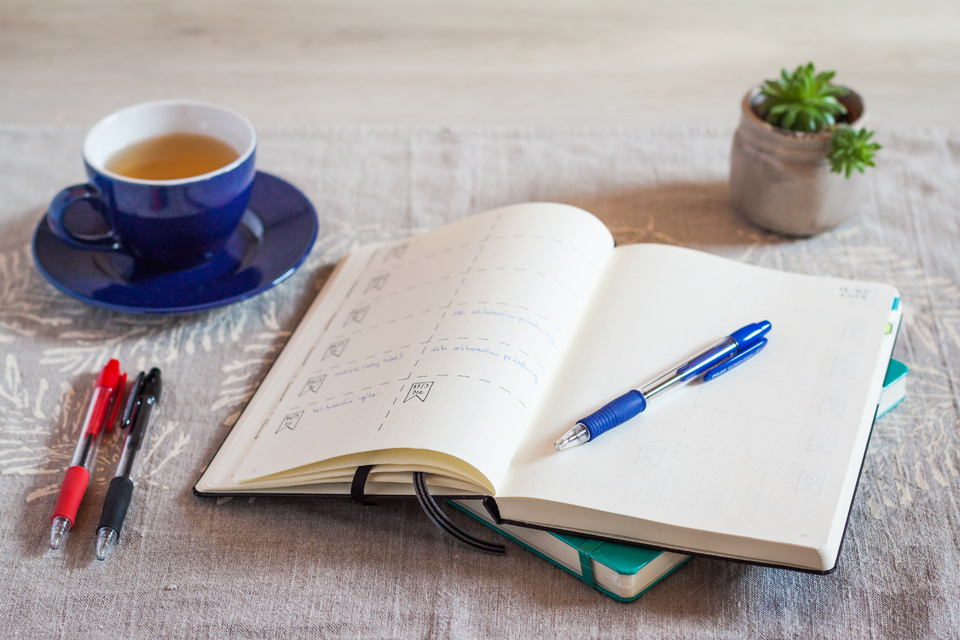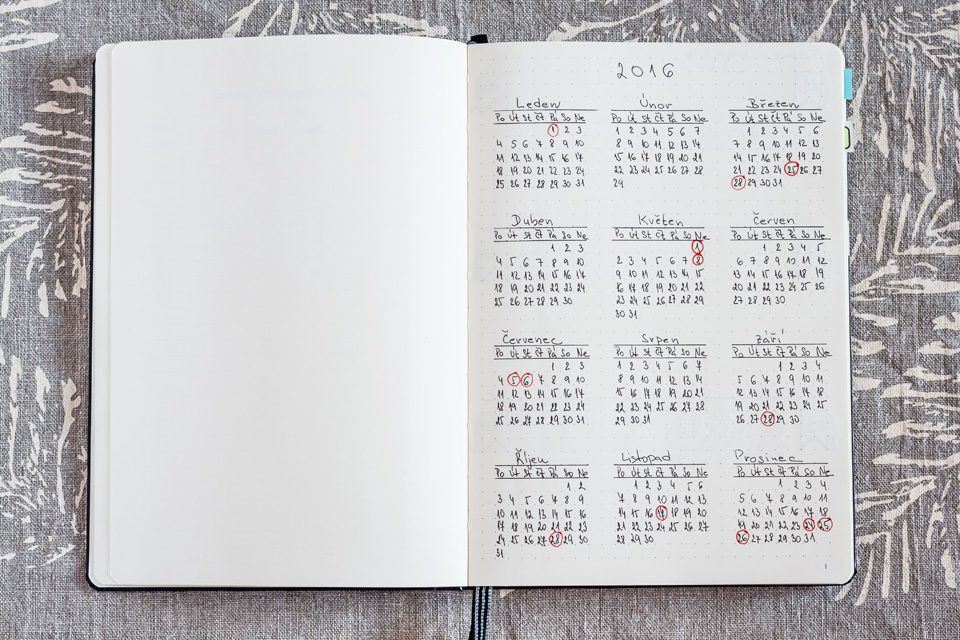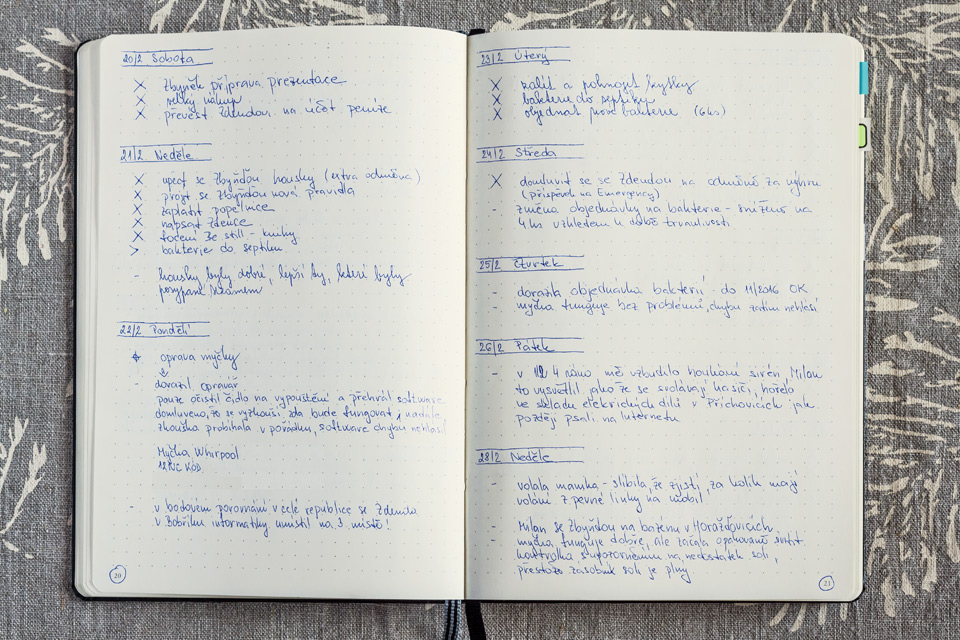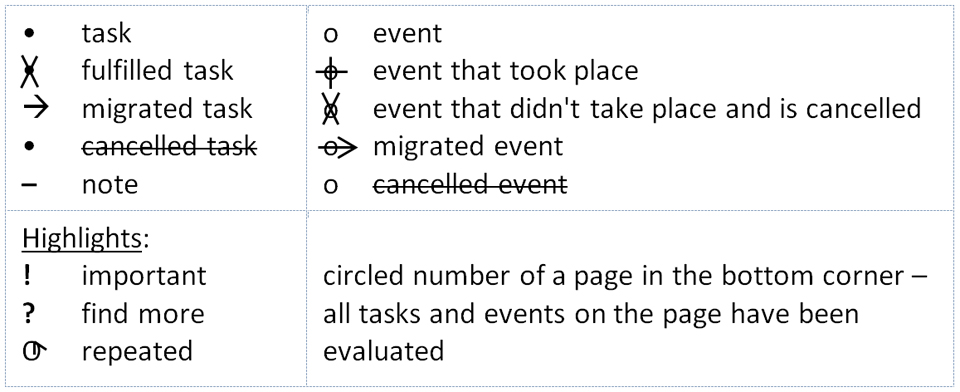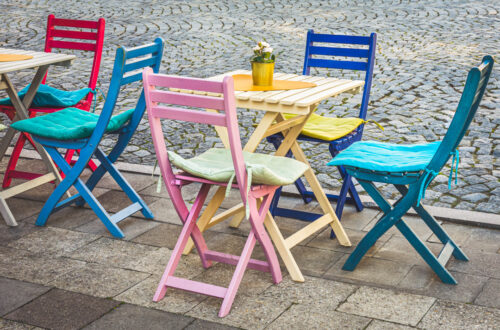Bullet journaling adventure
Have you ever heard of bullet journaling? It’s a way of keeping your events and tasks organized and much more than that and a few weeks ago it burst quite surprisingly into my life.
I disliked planners and diaries of all kinds. Always, when I bought one, I was carrying it for a few weeks in my bag, rarely opening it, and sooner or later it got lost in a drawer. They all seemed so rigid and unhelpful to me. I’ve been quite happy with my smartphone recently, it has all I need when it comes to scheduling events and jotting down important tasks.
But then, a few weeks ago, my attention caught bullet journaling mentioned in a comment. I hadn’t heard of bullet journaling before and it made me curious to find out what it refers to. To my big surprise I discovered a whole world of creativity and organization that left me speechless and feeling it’s something I’d love to try. I started to gather ideas how to possibly apply that system to my needs and read several interesting articles that helped me to decide.
When I was talking excitedly to my husband about my being intrigued by the system, he was listening to me patiently but I know that he thought I was going to start another thing I wouldn’t be able to keep up with and would feel stressed about. Nonetheless, when he finally saw the system in my use, he admitted that it really seems efficient and working for me. Not for him, he added, but he surprised me a few days later when he started to apply some of the principles to his own diary.
The idea of bullet journaling is based on the fact that you take a notebook (any notebook you wish) and a pen and create your diary along the way, adding as much or as little information and embellishment as you wish. No strictly prescribed columns and boxes, you are the one who controls the space. I love the non-digital nature of the system and its flexibility and the fact that everybody can make it as simple or as complex as they want or need.
If you google bullet journaling, you will get plenty of images and articles showing the possibilities. The thing is though that the amount of ideas and layouts one can find on the Internet is quite overwhelming and can mislead an inexperienced user so I decided to start with the basic layouts tweaked just a bit based on a few practical ideas I saw and liked. I love many of those elaborate journals people create but I know that for me it would truly be just the beginning of something I wouldn’t be able to keep up with.
You need to choose which notebook you want to start with and there is rich discussion among bullet journaling users about which is the best. I decided to start with the recommended Leuchtturm1917 notebook in its dotted version which I fell in love with. Would you believe that on this occasion I’ve seen a dotted notebook for the first time? We have notebooks with blank pages, squares or lines of various width, but no dots at all. That was my first problem, how to get it? Amazon and other foreign e-shops were way too expensive for me in this case but eventually I discovered that Leuchtturm is represented in Prague and Brno and I managed to order the notebook for an acceptable price there.
Now I’ll show you briefly the system I’ve had in place, I’ve been using it for about a month. It’s not embellished much, but it doesn’t need to be. It’s practical and keeps me on track. Most of it is written in my native Czech language and I hid some of my records from privacy reasons but you will get the idea.
Index is a list of pages and its contents at the beginning of the notebook intended to let you find quickly where your logs (daily/weekly/monthly records) and collections (pages gathering ideas, projects, drawings, quotes,…) live. I also use the two bookmarkers present in the notebook – one for the current week and one for the current day, and colour labels. This is the only table the Leuchtturm1917 notebook offers and I’d actually be happier if it wasn’t there as the first column is too narrow. But I can live with that.
Page 1. A year at a glance
Although my handwriting is not perfect, I love the hand-written look of the year. The red circles show public holidays in the Czech Republic.
Pages 2 – 5. Future log
Future log is intended for writing events and tasks scheduled in future, you can see that I still have none for the other half of the year. There are several ways of arranging the future log, I started with this original one. I think the size is big enough, if not, I can make amendments, adjust the system and change it next year. I saw the flags with months in someone’s journal and liked them but they occupy too much precious space here so next time I’ll do the description differently.
Page 6. Brief future log for following years
Page 7. A table of birthdays and name days of some family members and friends
Some planning reaches far forward and I find it useful to add that little outlook on the following years. As for the birthdays and name days, I have all these data in my mobile where there is more but I wanted to highlight these and pay more attention to them which is why I created this page. I could add the data to the future log but in this way I can copy them more easily next year.
Pages 8 – 15. Weekly logs
With weekly logs I differ from the original monthly logs, I like this more detailed system much better. I started on 8th February so my first spread starts with the 6th calendar week, 7th, 8th and 9th weeks follow. The last week of February is the first week of March so I decided I will always end the group of weeks with the week where the last day of the particular month is. On the left page of the weekly log, there are two columns for working days and one for both Saturday and Sunday. For working days, I put scheduled events to the left column and other events and tasks for that particular day to the right column. The right page of the weekly log is intended for events, tasks and notes relevant to that particular week regardless of the days.
Page 16. Monthly tracker for February
By means of a tracker you can quickly see how often you fulfil the more or less regular tasks and activities you want to keep your eye on. I love it. In this first tracker I noted down e.g. dates when I published my blog posts, dates when I was practising my photography, dates when I was speaking with my mom on the phone, and for March I added a few more. Whether I slept enough (because I tend to go to bed too late and then I’m tired in the morning), whether I ate any fresh vegetables or fruit (as I’ve been eating them quite rarely lately), whether I did any sport activities (as I definitely need doing something)… I don’t understand this tracking as cracking a whip over my head, I just like the visual value it has. At a glance you see what you need to know.
Pages 17 – 23. Daily logs from 8th February to 6th March
Every evening I sit down for a while, evaluate what’s done that day and jot down tasks and events for next day. During the day I add notes and/or other tasks and events.
On 29th February I drew next set of weekly logs for March which are 10th – 13th calendar weeks (pages 24 – 31), added a monthly tracker for March (page 32) and added my first collection which is a page where I want to track my weight in March and April (page 33).
I’d like to lose some weight but I haven’t planned any specific goals yet, I just want to track how it goes. Hopefully facing these data day by day will strengthen my determination and will help me to make an effort. On next page, daily logs continue.
To tell you in a nutshell how it all works together, let’s say that if I arrange an event or get a task today that is to be fulfilled this month, I write it down to the relevant week (either on its left or right page based on how date specific it is) and then when planning the particular day I transport the data to its daily log. If I arrange an event or get a task today that is to be fulfilled next month or any of the following months, I write it down to the future log. At the end of a month I create weekly logs for the following month and transport there all my notes from future log in that particular month and from the table with birthdays. I don’t use future log for that new month any more, it all lives in the weekly and daily logs then. At the end of a week I evaluate all tasks and events in the particular weekly log so that none stays “open”, the unfulfilled ones are either migrated or cancelled. Daily logs I evaluate daily.
I use the following simple set of symbols to see the status of the tasks, events and notes:
As I’ve mentioned before, my journal is quite simple, but one can add as many collections as they want – thoughts, quotes, ideas, drawings, projects, records of phone calls, trips, whatever comes to your mind.
I’m fully aware of the fact that the system works as long and as well as I’m willing to work with it. As everything, it needs its amount of time and effort. But already after the first month of using it I can see how much it helps me to be more efficient and not to forget the little pieces of information I need or would like to remember. I like working on my laptop and organise many things there but this system makes me more aware of thing I need to get done.
If you’re still with me at the end of this quite long post, I hope it’s a sign that my experience inspired or addressed you in some way. If you want to know more, I recommend you to read the original rules of the system, you can find them HERE. And of course, you can ask me if anything in my post isn’t clear enough or you would like to explain that further.



